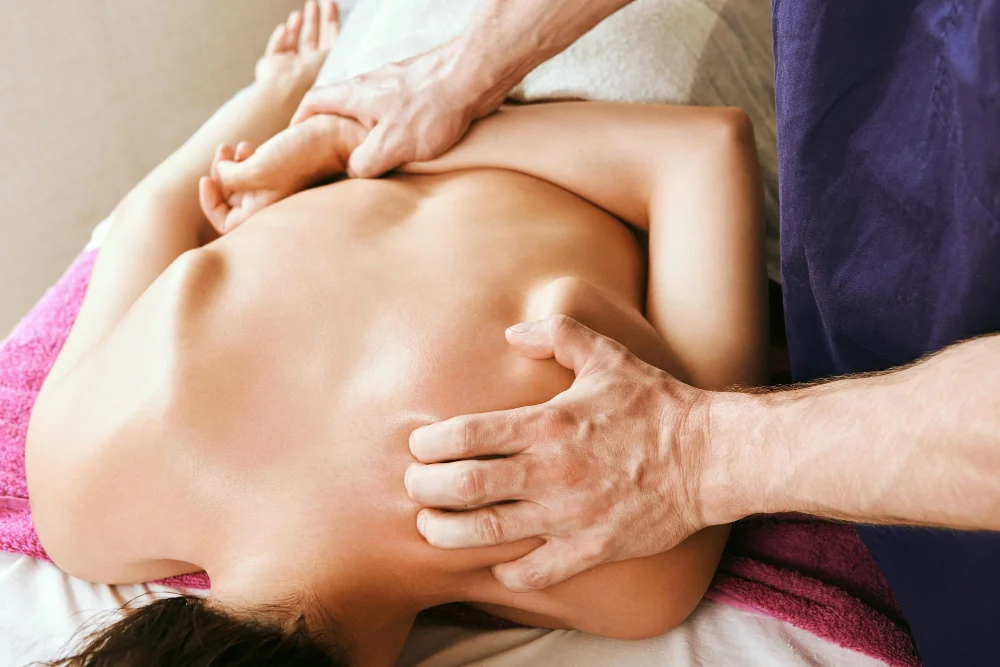Muscle pain can be a debilitating issue that affects daily life, physical activity, and overall well-being. Whether you are an athlete dealing with sore muscles, an office worker suffering from tightness due to poor posture, or someone experiencing chronic muscle pain, finding effective relief is crucial. Myo therapy, a specialized form of manual therapy, has gained attention for its targeted approach to relieving muscle pain and promoting recovery. But what exactly is myo therapy, and how can it help you?
In this ultimate guide, we will explore the principles behind myo therapy, the techniques used, the types of pain and conditions it treats, and how it can support your recovery journey. By the end, you’ll have a clear understanding of how myo therapy works and why it might be the right solution for your muscle pain and recovery needs.
What Is Myo Therapy?
Myo therapy, also known as myotherapy, is a form of physical therapy that focuses specifically on assessing, treating, and rehabilitating soft tissue pain, muscle tightness, and dysfunction. The term “myo” comes from the Greek word for muscle, and myo therapy zeroes in on muscle-related issues and imbalances. While similar to massage therapy and manual therapy, myo therapy takes a more targeted and structured approach, often incorporating a combination of hands-on techniques, corrective exercises, and patient education to provide lasting relief from muscle pain.
Myo therapists are trained to assess the root cause of muscle pain, looking at the interconnectedness of muscles, fascia, and posture to deliver comprehensive treatment. This holistic approach allows them to address both the symptoms and underlying causes of muscle pain, offering a pathway to long-term relief and improved muscle function.
The Principles Behind Myo Therapy
Myo therapy is built on the understanding that muscle pain and dysfunction are often linked to trigger points, muscle imbalances, and poor biomechanics. When muscles are tight, weak, or not functioning properly, they can create pain not only at the site of dysfunction but also in other areas of the body due to compensatory patterns. Myo therapy seeks to identify and treat these imbalances by targeting specific areas of pain, restoring proper muscle function, and promoting overall musculoskeletal health.
Key principles of myo therapy include:
- Holistic Assessment: Myo therapists assess the entire musculoskeletal system to identify muscle imbalances, postural issues, and compensatory patterns that may be contributing to pain.
- Trigger Point Focus: A primary focus of myo therapy is the identification and release of trigger points—hyper-irritable spots in muscles that can cause referred pain and dysfunction.
- Individualized Treatment Plans: Treatment is tailored to the individual’s specific needs, taking into account their physical condition, lifestyle, and goals for recovery.
- Active Participation: Myo therapy often includes a component of patient education and corrective exercises, empowering individuals to take an active role in their recovery process.
Techniques Used in Myo Therapy
Myo therapists use a variety of hands-on and corrective techniques to treat muscle pain and restore normal function. These techniques are designed to improve circulation, release muscle tension, and increase flexibility, ultimately promoting faster recovery. Common myo therapy techniques include:
1. Trigger Point Therapy
Trigger points are areas of tightness within muscle tissue that can cause localized pain or refer pain to other areas of the body. In myo therapy, therapists use focused pressure on these trigger points to release tension and alleviate pain. By reducing muscle knots and restoring normal muscle function, trigger point therapy provides significant relief for individuals suffering from muscle tightness and discomfort.
2. Myofascial Release
Myofascial release involves applying sustained pressure to the fascia—the connective tissue surrounding muscles—to release restrictions and increase range of motion. This technique helps reduce stiffness, improve flexibility, and alleviate pain associated with tight or restricted fascia. Myofascial release is particularly effective for individuals dealing with chronic pain or tension caused by poor posture, injury, or overuse.

3. Deep Tissue Massage
Deep tissue massage targets the deeper layers of muscle and connective tissue to break up adhesions, reduce scar tissue, and release chronic muscle tension. This technique is especially useful for treating chronic muscle pain, sports injuries, and postural issues. Deep tissue massage not only provides relief from pain but also improves circulation, which supports the body’s natural healing processes.
4. Dry Needling
Dry needling is a technique where thin needles are inserted into trigger points or tight muscle bands to stimulate muscle release and reduce pain. While not every myo therapist may offer dry needling, it can be an effective treatment for individuals with chronic pain or muscle tightness that does not respond well to manual pressure alone. Dry needling helps relax tight muscles, increase blood flow, and promote healing in the affected areas.
5. Corrective Exercise and Stretching
In addition to hands-on treatment, myo therapy often includes corrective exercises and stretching routines designed to strengthen weak muscles, improve posture, and restore proper movement patterns. These exercises are tailored to the individual’s needs and are aimed at preventing future muscle pain and dysfunction. By addressing the root cause of muscle imbalances, corrective exercises can help maintain the benefits of myo therapy long after the treatment session is over.
Conditions Treated by Myo Therapy
Myo therapy is a versatile treatment option that can be used to address a wide range of musculoskeletal conditions and pain issues. Some of the most common conditions treated by myo therapy include:
1. Chronic Muscle Pain
Chronic muscle pain, often caused by poor posture, overuse, or stress, can significantly impact daily life. Myo therapy is highly effective for treating chronic pain conditions like tension headaches, lower back pain, and neck pain by releasing trigger points and addressing muscle imbalances.
2. Sports Injuries
Athletes frequently experience muscle strains, overuse injuries, and tightness that can limit performance and recovery. Myo therapy is a valuable tool for treating sports injuries, improving muscle function, and accelerating recovery times. Techniques such as deep tissue massage and myofascial release can help athletes recover from injuries while preventing future muscle imbalances.
3. Postural Issues
Many individuals suffer from postural problems due to prolonged sitting, poor ergonomics, or muscle imbalances. Myo therapy can help correct these issues by releasing tight muscles, strengthening weak areas, and restoring proper alignment. This not only alleviates pain but also improves overall posture and body mechanics.
4. Referred Pain
Trigger points in one area of the body can often cause referred pain in other areas. For example, trigger points in the neck can lead to headaches or pain in the shoulder. Myo therapy is particularly effective at identifying and treating the root cause of referred pain, providing lasting relief.
5. Injury Rehabilitation
After an injury, muscles can become tight or weak due to disuse or compensatory patterns. Myo therapy helps restore normal muscle function during rehabilitation by improving circulation, reducing scar tissue, and enhancing mobility. This supports a faster and more complete recovery process.
How Myo Therapy Supports Recovery
Recovery from muscle pain, injury, or physical exertion is a critical aspect of maintaining overall health and well-being. Myo therapy plays a key role in promoting faster and more efficient recovery by:
- Increasing Circulation: Improved blood flow to muscles and soft tissues enhances the delivery of oxygen and nutrients, promoting faster healing and tissue repair.
- Reducing Inflammation: By releasing tension and reducing trigger points, myo therapy helps minimize inflammation, which is often a cause of pain and stiffness.
- Improving Flexibility and Mobility: Stretching and myofascial release techniques improve flexibility and range of motion, allowing individuals to move more freely and with less discomfort.
- Preventing Recurrence of Pain: Through corrective exercises and education on proper posture and movement patterns, myo therapy helps prevent the recurrence of pain and muscle dysfunction.
Who Can Benefit from Myo Therapy?
Myo therapy is beneficial for a wide range of individuals, from athletes looking to optimize performance and recovery to office workers dealing with muscle tightness from prolonged sitting. People suffering from chronic pain, tension, or muscle-related injuries can also experience significant relief from myo therapy. Whether you’re seeking relief from a specific issue or simply want to improve your overall muscle health, myo therapy offers a personalized approach to pain relief and recovery.
What to Expect During a Myo Therapy Session
During a myo therapy session, the therapist will begin by assessing your pain and overall musculoskeletal health. This may involve evaluating your posture, testing range of motion, and identifying trigger points or areas of muscle tightness. Based on this assessment, the therapist will develop a treatment plan that may include hands-on techniques such as deep tissue massage, trigger point therapy, and myofascial release, along with corrective exercises to support long-term improvement.
Sessions typically last 45 minutes to an hour, and the therapist may recommend a series of treatments depending on the severity of your condition. After the session, you may experience some soreness as the muscles adjust, but this typically subsides within a day or two, leaving you feeling more relaxed and pain-free.
Conclusion: Myo Therapy for Lasting Muscle Pain Relief
Myo therapy is a powerful, targeted approach to muscle pain relief and recovery. By addressing the root causes of muscle pain—whether from trigger points, postural issues, or muscle imbalances—myo therapy offers lasting relief and improved function. With its combination of hands-on techniques and corrective exercises, myo therapy is an excellent option for anyone looking to reduce pain, enhance mobility, and support long-term muscle health.
Whether you’re dealing with chronic pain, recovering from an injury, or simply looking to improve your muscle function, myo therapy could be the key to a pain-free, active life.

